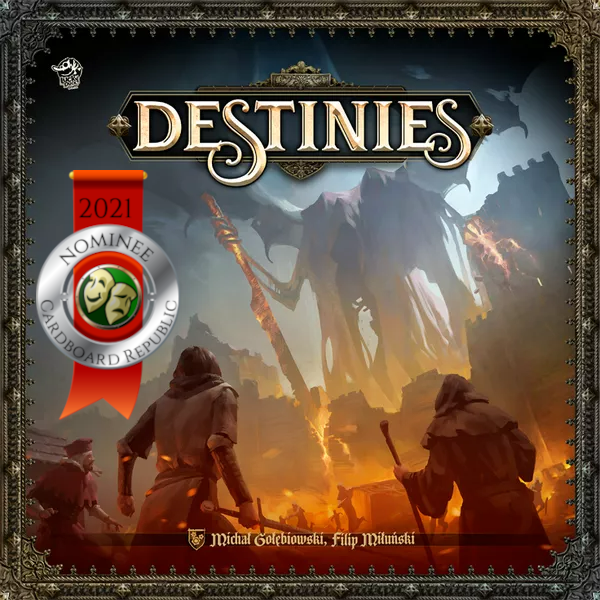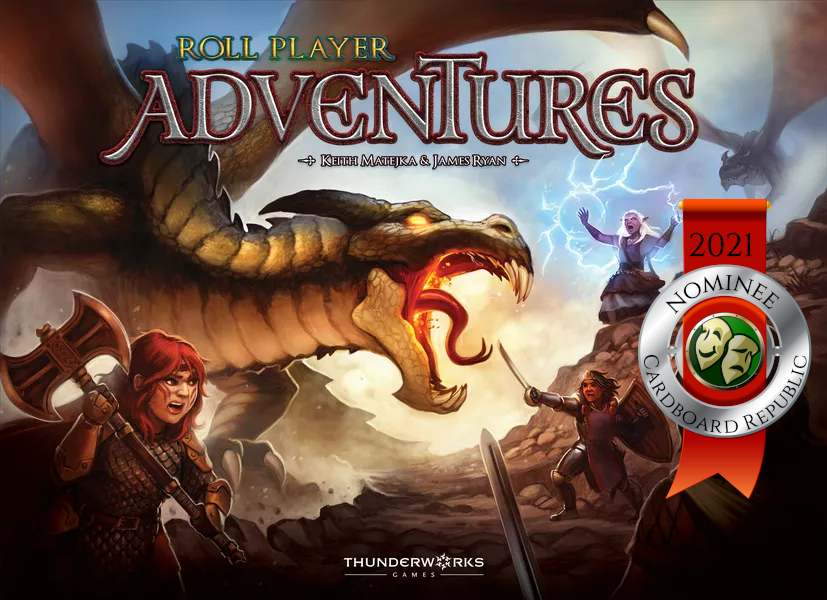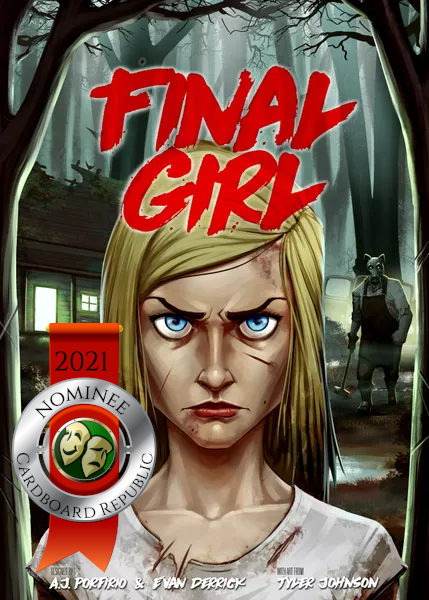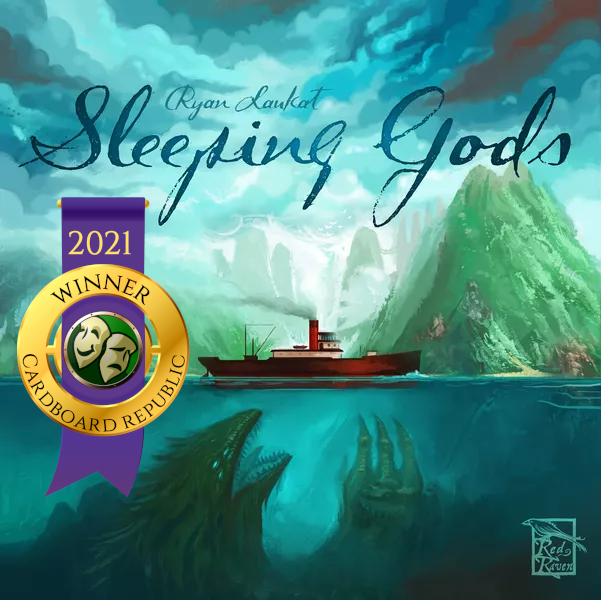The Cardboard Republic has rolled out the annual Laurels of the Republic awards, celebrating the best new games released in 2021 for each of the gamer archetypes. What follows are the finalists for one of those groups.
 From the depths of a cavernous dungeon, to the cold reaches of a distant conflict in outer space, to the exploration of the human condition, Immersionists thrive on a game’s locale. This group gets its biggest enjoyment out of games with rich settings that either tell some kind of story or serve some kind of purpose – games existing solely on basic mechanical or tactical choices are their kryptonite. Their driving interest revolves more around whether a particular mechanic or component fits whatever narrative is being told than if it’s the most ideal option. Immersionists want to be part of the game and feel as if their character belongs there. These roleplayers and worldbuilders demand that flavor actually matter to hold their interest – something more designers have been taking to heart in recent years.
From the depths of a cavernous dungeon, to the cold reaches of a distant conflict in outer space, to the exploration of the human condition, Immersionists thrive on a game’s locale. This group gets its biggest enjoyment out of games with rich settings that either tell some kind of story or serve some kind of purpose – games existing solely on basic mechanical or tactical choices are their kryptonite. Their driving interest revolves more around whether a particular mechanic or component fits whatever narrative is being told than if it’s the most ideal option. Immersionists want to be part of the game and feel as if their character belongs there. These roleplayers and worldbuilders demand that flavor actually matter to hold their interest – something more designers have been taking to heart in recent years.
And with that, here are The 2021 Laurel Finalists for Immersionists:
Honorable Mention: Mind MGMT: The Psychic Espionage “Game.”
Publisher: Off the Page Games | Players: 1-5 | Play Time: 45-75 Minutes
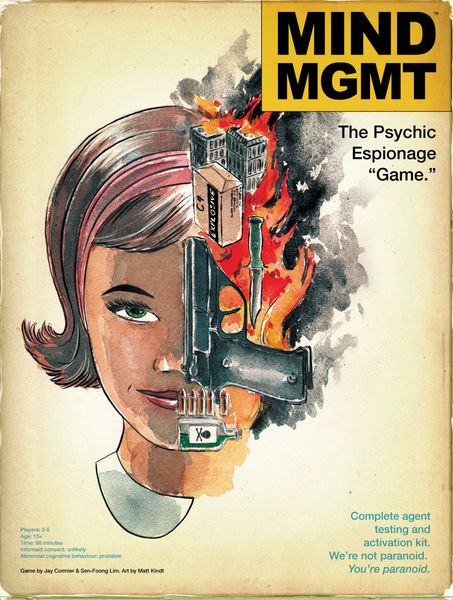
When it comes to games that plunge its players into profoundly creative, stylized, and engaging settings 2021 was an exemplary year, with impressive array of highly entertaining, highly thematic games. These came in many forms, from small titles of psychological dueling, to a litany of surprisingly cogent licensed titles aptly capturing the nature of their respective properties, to banner new editions of one of the most definitive dungeon crawlers and semi co-op titles of the modern era (in Descent and Battlestar Galactica, now Unfathomable, respectively). Narrowing this year’s list down was particularly arduous, if only because there were so many worthwhile options.
But it would be remiss to not include the hidden movement indie darling Mind MGMT among them – coincidentally reinforcing that quality games come from every conceivable corner of the hobby.
Based on a graphic novel series set in an alternative, slightly retro-themed modern day, in Mind MGMT a shadowy group seeks to recruit people with psychic abilities and use them to shape world events. Once a noble mission of maintaining peace, this group’s ambitions have turned towards unbridled control.
Throughout this innovative take on the One v All game model, one player acts as a Recruiter, moving secretly about the board recruiting new members. Initially operating with a sense of security as you work behind the scenes, each major step towards your agenda risks exposing intel to the other side, stirring up notions of isolation and paranoia.
Standing against them are the remaining players as rogue agents with powers of their own. Their singular goal: stop the syndicate before it’s too late. Ideally acting cohesively and collaboratively, deceptive maneuvering by a cunning Recruiter can leave others disoriented and adrift. Only through coordinated discussion and logic as a group do you stand a chance, burnishing a palpable sense of team-based camaraderie.
While the basics to hidden movement games are well-established, what makes Mind MGMT particularly noteworthy is the way it incorporates its theme while expanding on and evolving the model by including elements of board tracking, set collecting, and even modest board control. It also introduces an entire adaptable (but non-legacy) rules system, such that the losing side gains additional benefits in subsequent playthroughs.
Outwardly Mind MGMT may seem like a stock hidden movement game, but just like the supernatural spycraft within, there is far more beneath its surface than it seems. The result is a dynamic, tension-filled, brain burning exercise for everyone involved, bolstered by a thematic climate where tension and uncertainty over who has the upper hand ratchets up with every turn. With that in mind, you don’t need to be a psychic to understand its Immersionist appeal.
The Nominees

Number Five: Destinies
Publisher: Lucky Duck Games | Players: 1-3 | Play Time: 90-150 Minutes
For millennia board games have been played on every kind of surface and come replete with pieces made of wood and cardboard and stone; with tumbling dice, decks of cards, and plastic standees from every corner of the rainbow. They are social, portable, visually enticing, and of course, entirely self-contained.
Yet the advent of modern technologies challenged long-held definitions, particularly along the analog/digital chasm, with the ubiquitous rise of smartphones and the idea of the app-enabled board game.
Reception to such games has been, to put it nicely, uneven. The reasons for this vary, but ultimately the most determinative factor as to whether gamers will accept an app game revolves around its presence simplifying or enhancing the overall experience rather than reducing interactivity or agency by replacing too many of its physical qualities.
Destiny deftly avoids such pitfalls.
Set in a grim alternate medieval universe of myth and magic, Destinies drops players into a world undergoing challenges of biblical proportions. Literally. Throughout a series of partially linked scenarios, players select from a trio of possible characters in each story with the goal of completing that character’s narrative story arc. Much of this transpires through a familiar turn-taking process of exploring locations, fulfilling quests, fighting unholy creatures, and interacting with NPCs. Overcoming challenges is accomplished through a mix of items, adjustable skill tracks, and the fate of the die roll.
However, a cooperative adventuring romp this is not. In this intriguingly competitive storytelling venture only one player can achieve the ending they seek, and that goal is kept secret. Each character even has two different questing paths to accomplish this, fueling a tenor of uncertainty and low-level tension that hangs in the air.
While much of the game still transpires physically, all of Destinies’ storybook functions (besides oration itself) resides with the app. Using items often involve scanning a QR code, and storyline event triggers are obfuscated until foisted upon you. Through it your story decisions can even directly modify future interactions for other players. Combined, these elements create a malleable and forking narrative that would be an implementation headache otherwise but is effortlessly handled via the app. Procedurally its digitization is an organizational unburdening, not a portent of doom.
Destinies set out to be an ideal hybrid board game experience that integrates digital efficiency alongside traditional analog appeal to create a compelling and highly thematic narrative experience. To the exuberance of many, particularly among Immersionists, it does precisely that. With an express focus on exploring a world under pressure in the pursuit of secret agendas, visually enticing components, and a streamlined, centralized app that controls but doesn’t overpower the game’s focus, Destinies makes for a darkly bewitching journey worth undertaking.
Number Four: Roll Player Adventures
Publisher: Thunderworks Games | Players: 1-4 | Play Time: 90-150 Minutes
Here we are again.
Back in 2015 Thunderworks Games and designer Keith Matejka quietly launched a Kickstarter for Roll Player – a lightweight dice drafting and allocation game with the charmingly novel theme of players essentially acting out a gamified version of the RPG character creation process. Hence the title.
Little did anyone realize at the time just how profound its release the following year would be. Not only did garner both an extensive casual fanbase and critical accolades (itself one of our 2016 Indie Spotlight titles and the 2016 Architect Laurel Honorable Mention), but it in turn set in motion the creation of an entire in-game universe complete with several direct expansions and multiple game spinoffs replete with expansions of their own (Cartographers itself being a 2019 Socializer nominee even).
In a way, Roll Player Adventures brings the entire saga full circle with Thunderworks’ most ambitious but strangely fitting title to date. In Roll Player you created a character to venture forth in a world that didn’t exist. Thanks to RPA, now it does.
Roll Player Adventures is a sprawling but straightforward co-op narrative game that guides players through nearly a dozen adventure scenarios. Here, players are a merry band of do-gooders slowly progressing through myriad dice-based foes and challenges. Characters can be chosen from the game’s pre-made pool, or in a clever bit of cross-compatibility flavor, “imported” from the original Roll Player, creating characters with unique traits, stats, and equipment.
Eschewing turns, questing throughout RPA is done as a single unit, with its main thrust being to explore. Nearly every game location has its own storyline prompts that can fork, change, or advance the main plot in some way – even upon revisiting – depending on a mix of obtaining items, completing tasks, basic player choices, or the outcome of various challenges.
The mechanical core of RPA is, expectedly, dice based. Skill checks and creature combat work similarly, with players tasked to allocate a number of dice of specific colors and/or values (based on the challenge) by randomly drawing and rolling dice. Using individual player cards and abilities, the team must collectively augment that dice pool to ensure success.
Rather than tailor the story around the dice, Roll Player Adventures keenly does the opposite. It proudly lets the game be propelled by an expansive, intriguing, and interactive storyline (complete with narrative prompts of lasting consequence) more than its laudable and accessible dice mitigation puzzle. That subtle distinction is not lost on this group, who cherish any well-implemented game where the story is the main driver. Roll Player Adventures does not disappoint to that end, adeptly merging enjoyably familiar mechanics alongside a rich, well produced, and scalable adventure chronicle.
Number Three: Final Girl
Publisher: Van Ryder Games | Players: 1 | Play Time: 30-60 Minutes
Lacking the social rewards of playing with others, a solo game experience lives or dies through capturing and holding your attention with the challenges or condundums it offers. Games designed exclusively for solo play are even more acutely aware of the stakes – if it can’t ensnare you with rapt interest, it fails its singular purpose. And there is no alternative.
Final Girl does not have such a fate. If anything, for a game centered around grisly deaths, it’s a particularly lively exercise.
You’ve heard the names before. Freddy. Jason. Michael. From Ghostface to Leatherface, Xenomorphs to Cenobites, horror films (and slasher films in particular) are rife with recognizable villains, gruesome and elaborate death scenes, and more than a few poorly made decisions. Yet most of these films also share in common the Final Girl: the female protagonist and (usually) sole survivor who, despite all the horrors endured and hardships faced, inevitably confronts and defeats her tormentor. It’s such a common horror trope that movies routinely vacillate between honoring and subverting it.
Final Girl the board game embraces this wholeheartedly, with appreciable care and extensive attention to even minor flavorful details. Allusions abound in this thematic solo sprint for survival. The payoff being one of the most captivating solo games not just of 2021 but of the entire solo field overall.
Through an alternating cat-and-mouse process, your turns involve spending time points to play cards that let you move around the board, make attacks, and scour for items. Dice rolls then determine how well – or if – that action happens. However, time points are also necessary to obtain cards for the next turn, leading to an excruciatingly tight action economy and keeping you endlessly teetering on the edge of failure. By contrast, your supernatural enemy…mostly moves and stabs people, growing stronger with every kill.
Through these limited actions, the whims of the dice, and the looming monstrosity stalking you, Final Girl fosters an ambiance permeated by anxiety and foreboding dread and is set against a well-implemented horror-themed backdrop. It’s not easy to do, but Final Girl captures that dark cinematic essence and distills it into a laudable single player gauntlet. To horror fans and Immersionists alike that degree of thematic engagement is as mesmeric as it is irresistible.
Using a modular ‘framework’ system (one of two on this list), Final Girl lets you play a series of different tales, each with their own settings, villains, Final Girls, and distinct lore to draw you in. Many elements are even interchangeable between stories, offering extensive variability in your quests for survival. Yet in every case the premise is simple: kill your foe or die trying.
And you will.
A lot.
Number Two: Unsettled
Publisher: Orange Nebula | Players: 2-4 | Play Time: 60-90 Minutes
Deep in the far reaches of uncharted space, you and your stalwart crew realize you’re kind of screwed. You don’t have the necessary resources to make it back home, and they’re dwindling by the day. Your only hope is to find what you need on nearby but completely uncharted alien worlds. It won’t be easy, and you have no idea exactly what lies in store, but you also figure what the hell. If you’re going to be killed off by the cold, unfeeling recesses of space, you might as well do it in style. And hey, you might also actually survive the ordeal.
Maybe.
Such is the spirit of Unsettled, a fully co-op sci-fi sandbox game of adventure and survival that’s equal parts optimization puzzle and engrossing narrative storytelling. Here, players are working with one another and against the endurance clock to accomplish a preselected set of survival tasks. These tasks are varied, multifaceted, and accomplishing them will not be easy.
Doing so involves the game’s core mechanic of assigning focus cubes to desired actions. Optimal outcomes in this process are fluid, however, as the cubes’ values oscillate based on how you use them, and actions themselves can fluctuate in effect – or be blocked entirely – based on how the game unfolds. Diligence, flexibility, and teamwork are vital if you have any hopes of victory. And you do! A little, anyway.
Yet irrespective of all its obstacles, Unsettled also teems with levity and humor, never taking itself overly seriously while it’s trying to kill you.
Above all, though, Unsettled is about the unbridled joy – and danger – of exploration. Unlike many sci-fi games about colonizing alien worlds or suppressing the dangers you face, Unsettled is about embracing the risks and rewards of discovering the unknown purely for the sake of it. There are no monsters to fight or villains to overcome. It’s just you, your crew, and the ticking clock. It encourages you to wantonly kick over rocks and poke things with sticks to see what happens, and then giddily rewards you with the ramifications. Sometimes it will be new actions, abilities, or upgrades. Sometimes you get spritzed by psychedelic fungi. Likely both.
While each of Unsettled’s worlds provide distinctive thematic forays that differs wildly in flavor and function, all of them provide an experience that’s smooth and dynamic, with minimal downtime and stellar cooperative gameplay. It’s tough yet charming, ridiculous yet captivating, and all firmly with a focus on interacting with the world before you. To Immersionists, this is handily the kind of space game they will go boldly to, and rightfully so.
So much so that despite its late year release challenges, Unsettled made a decent run at this year’s Laurel. And it even had a shot if not for an entirely different ship…
The Winner
2021 Immersionist Laurel – Sleeping Gods
Publisher: Red Raven Games | Players: 1-4 | Play Time: 60-1200 Minutes
We’re not entirely shocked we ended up here. Typically during these annual processes it’s like navigating a ship in the fog, never quite knowing what the landscape will look like when the clouds part. In this case it was pretty much full steam ahead. That we would be talking about Sleeping Gods in some capacity as one of thematically-driven vanguards of 2021 seemed inevitable in hindsight. Glimpsing an early version in 2019, we knew this nautical themed game was going to be a splash long before it went up on Kickstarter, and its finished form only reinforced that assessment.
From an immersive storytelling standpoint, yes, it really is that good.
For those familiar with Ryan Laukat’s trademark style, this should come as no surprise. Laukat and his Red Raven team have become known for games that cherish narrative-driven tales with a sense of wonderment and an emphasis on exploration, where anyone is welcome and there’s always more to uncover. All of which is brought to life through equally stimulating artwork. Serving as designer, artist, publisher, and storyteller, Ryan’s imaginative visions have been brought to life numerous times. Sleeping Gods is the largest and most ambitious of them to date.
Set circa 1930, Sleeping Gods follows the travails of the steamship Manticore who has suddenly and strangely found itself transported to unknown shores. In this fully cooperative game of discovery and adventure, players each control part of the crew while taking turns moving about as its captain. Presented in an atlas form, you are only ever able to glimpse part of the world at a time, which means sailing to another section can literally mean changing the page. Yet this only furthers the thematic sense that you’re not sure where you are – or how to get home.
Compounding that is a nonstop cycle of events and encounter-laden story locations, where players continuously find themselves prompted with choices to make and the ramifications thereof. Some exist for pure worldbuilding flavor, but most interactions involve performing some kind of skill check or fending off monsters. As the game progresses you will gain a bevy of weapons, abilities, upgrades, and shipboard assets to aid you, but so too grows your obstacles.
While the mechanical engine in Sleeping Gods is a (generally) straightforward balancing act of trying to stay afloat while venturing ever forward, its unabashed heart and soul is a team-based interactive story campaign which buoys everything else. It drops players into a compelling tale of lost sailors trying to determine why they’re there and how to get back, a fantastical journey on a level that would make Odysseus blanch. Sleeping Gods is accessible, scalable, highly interactive, and envelops players in a setting that leaves you continually desiring to find out what’s next over the horizon.
And it is precisely for those reasons why it sailed to this year’s Laurel.
![]()
Sleeping Gods Contest!
We thought about different ways to highlight how great the winning title of the Immersionist Laurel is. We tried to come up with some clever and thematic ideas, such as renting out a small boat to go touring around local waters. However, despite getting fairly far along in the planning stages we had to (figuratively) scuttle that plan. Officially it was a case of few people wanting to cruise around cold New England coastal waters in early spring. Unofficially we mostly didn’t want to get into another tiff with the Bob Denver estate thinking we were picking on the guy again. We also considered focusing a contest around a series of mapmaking challenges given how much of the game is about nautical seafaring. Alas, that one didn’t pan out either because our intern Claudius got lost trying to get some blank maps photocopied at the local Staples. Like completely MIA for 6 days and ending up deep in the Green Mountains of Vermont lost. And ironically no where near water. We took that as also probably a bad sign. So in the end we opted for a simpler approach: providing one lucky winner with the opportunity to enjoy the award-winning game first hand.
Note: In honor of their award recognition, Red Raven Games has kindly provided a copy of this game for giveaway purposes.
![]()
Be sure to check out the 2021 Laurel Award pages for the other archetypes once they go live!

